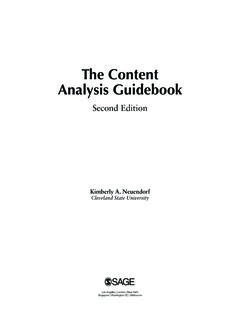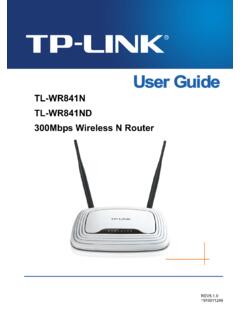Transcription of Introduction to Satellite Communication 3rd Edition
1 Introduction to Satellite Communication Third Edition For a listing of recent titles in the Artech House Space Application Series, turn to the back of this book. Introduction to Satellite Communication Third Edition Bruce R. Elbert Library of Congress Cataloging-in-Publication Data A catalog record for this book is available from the Library of Congress. British Library Cataloguing in Publication Data A catalogue record for this book is available from the British Library. ISBN-13: 978-1-59693-210-4. Cover design by Yekaterina Ratner 2008 ARTECH HOUSE, INC. 685 Canton Street Norwood, MA 02062. All rights reserved. Printed and bound in the United States of America. No part of this book may be reproduced or utilized in any form or by any means, electronic or mechanical, including photocopying, recording, or by any information storage and retrieval system, without permission in writing from the publisher. All terms mentioned in this book that are known to be trademarks or service marks have been appropriately capitalized.
2 Artech House cannot attest to the accuracy of this information. Use of a term in this book should not be regarded as affecting the validity of any trademark or service mark. 10 9 8 7 6 5 4 3 2 1. Contents Preface xi chapter 1. Fundamentals of Satellite Systems 1. Basic Characteristics of Satellites 1. Advantages of Satellite Communication 7. Use of Microwave Frequencies 11. Digital Transmission, Compression, and Routing 12. Improved Space Platforms and Launching Systems 13. Integration with Terrestrial Wired and Wireless Networks 14. System Elements 15. Space Segment 15. Ground Segment 17. Overall System 20. Satellite Orbit Configurations 20. Frequency Spectrum Allocations 22. ITU Spectrum Allocations and Regions 24. VHF and UHF Frequency Ranges 26. Microwave Bands: L and S 27. Microwave Bands: C, X, and Ku 31. Millimeter Wave and Higher: Ka-, Q-, and V-Bands 35. Guided and Unguided Optical Properties 36. References 38.
3 chapter 2. Evolution of Satellite Communication 39. Source of the Original Idea 39. SYNCOM 40. COMSAT 41. Evolving Satellite Coverage 42. Global Service: INTELSAT, PanAmSat, and Orion 42. Regional Coverage: EUTELSAT and SES 50. Domestic Systems: Telesat, Westar, and Palapa 51. Specialized Systems: DTH and mobile 60. DTH Development 61. MSS Development 62. Digital Information Broadcasting 64. v vi Contents Expansion at Higher Frequency Bands: Ka-Band 66. References 68. chapter 3. Satellite Network Architectures 69. General Features of Satellite Networks 69. Dedicated Bandwidth Services 71. Circuit-Switched Services 75. Packet-Switched Services 77. Flexibility Features 78. Reliability of Satellites and Links 81. Quality Features and Issues 82. Point-to-Multipoint ( broadcast ) Networks 88. Video Distribution 89. Direct-to-Home Television 96. Content Distribution Networks 97. mobile Satellite Communications 99. Point-to-Point Networks 104.
4 VSAT Networks 105. References 107. chapter 4. Microwave Link Engineering 109. The Decibel 109. Propagation on the Earth-Space Link 111. Basic Microwave Propagation 112. Isotropic Radiator 113. Directional Properties of Antennas 115. Polarization (Linear and Circular) 119. Propagation Losses 123. Microwave Transmitters and Receivers 133. Transmitting Station 133. Receiving Station 139. Definition of a Transponder 140. Overall Link Quality 142. How Noise and Interference Affect a Microwave Link 142. Carrier-to-Noise Ratio 144. Link Budget Analysis 146. Link Margin 148. References 149. chapter 5. Modulation, Multiple Access, and Impairments 151. Digital Baseband Signals and Hierarchies 151. Digital Information Sources and Bandwidth Requirements 153. Analog-to-Digital Conversion 156. Contents vii Compression 158. Error Detection and Correction 159. Scrambling and Encryption 162. Digital Modulation 165. Frequency Shift Keying 169.
5 Phase Shift Keying 169. Amplitude and Phase Shift Keying 171. Multiple Access Methods 172. Frequency Division Multiple Access 173. Time Division Multiple Access 175. ALOHA Packet Multiple Access 177. Code Division Multiple Access 179. RF Bandwidth Utilization in Multiple Access 181. Distortion and Impairments 183. Digital Signal Impairments 183. Transponder Intermodulation Impairment 185. Uplink and Downlink RF Interference 189. References 193. chapter 6. Spacecraft and Repeater 195. Overview of Communications Spacecraft 195. Overall Payload Requirements 198. Transmit Effective Isotropic Radiated Power (EIRP) 199. Receive Gain-to-Noise Temperature Ratio (G/T) 203. Bent-Pipe Transponder Filtering 204. Linearity 205. Frequency Translation Effects 206. Analog Bent-Pipe Repeaters 208. Digital Processing Repeaters 208. Multiple Beam Switching and Routing 209. Digital Processor Architecture 212. Demod-Remod Repeater 215.
6 Standard Repeater Elements 216. Wideband Receiver 217. Redundancy Switching 219. Waveguide Filters and Multiplexers 224. Traveling Wave Tube Amplifiers 228. Solid-State Power Amplifiers 232. Transponder Gain Control and Linearization 234. References 236. chapter 7. Spacecraft Antennas 237. Horn Antennas 237. viii Contents Reflector Antennas 243. Center-Fed Parabolic Reflectors 246. Offset-Fed Parabolic Reflectors 249. Antenna Patterns 251. Direct Radiating Array Antennas 255. References 256. chapter 8. Spacecraft Mission and Bus Subsystems 257. Mission Summary 257. GEO Mission Profile 257. On-Station Operation Requirements 258. Non-GEO Requirements 259. Spacecraft Configuration 260. Spacecraft Bus Subsystems 262. Attitude-Control Subsystem 262. Solar Cells and Panels 268. Battery Design and Configuration 271. Liquid Propulsion System 274. Electric and Ion Propulsion 278. Solid-Fuel Rocket Motors 279. Tracking, Telemetry, and Command (TT&C) 280.
7 Thermal Control 286. Structural Arrangements 289. References 289. chapter 9. Earth Stations and Network Technology 291. Basic Earth Station Configuration 291. Performance Requirements 294. Transmit EIRP 294. Receive G/T 295. Location and Platform Requirements 297. Radio Frequency Equipment 299. Antennas for Earth Stations 300. Antenna Beam Pointing 302. High-Power Amplifiers 302. Upconverters and Downconverters 304. RF Combining 305. Uplink Power Control 305. Intermediate Frequency and Baseband Equipment 306. Modulators, Demodulators, and Modems 306. Multiplexing and Packet Processing 307. Tail Links and Terrestrial Interface 307. Terrestrial Tail Options 308. Terrestrial Network Interfaces 310. Contents ix Earth Station Facility Design 311. Major Classes of Earth Stations 313. TT&C Ground Facilities 314. TV Uplinks and broadcast Centers 319. FDMA Digital Communications Service 322. Full-Mesh TDMA Earth Station 324.
8 VSAT Star Network Terminal 326. TV Receive-Only Design 330. MSS User Terminals 334. References 336. chapter 10. Launch Vehicles and Services 337. The Launch Mission 338. The Boost Phase 339. Non-GEO Missions 341. Geostationary Transfer Orbit 342. Drift Orbit for GEO Operation 343. Deployments and In-Orbit Testing 345. RCS Fuel Allocation 346. Launch Technology and Systems 349. Typical Launch Vehicles 351. Ariane 352. Atlas 353. Delta 354. H-1 and H-2 354. Long March 355. Proton 356. Zenit 358. Launch Interfaces 359. Physical Launch Interfaces 359. Management Interfaces 360. Risk Management in Launch and Operation 361. Launch Insurance 362. Backup and Replacement Satellites 364. chapter 11. Satellite Operations and Organization 367. The Satellite Control System 367. GEO Satellite Control 369. Non-GEO Satellite Control 371. Intercommunication Networks 372. Backbone Communications 373. Alternate Routing for High Reliability 374.
9 Network Management 375. x Contents Network Operations 375. Standard GEO Transponder Services 376. User Network Monitor and Control 379. Payload Configuration Management 381. Human Resources for Satellite Operations 382. References 387. chapter 12. Satellite Systems Engineering and Economics 389. Satellite Systems Engineering Principles 389. Fixed Satellite Systems and Services 392. mobile Satellite Systems and Services 393. Satellite System Economic Principles 393. System Development Methodology 395. Space Segment Economics 398. Space Segment Investment Cost Elements 401. Annual Space Segment Costs 405. Earth Station Economics 407. Earth Station Investment Cost Elements 408. Annual Costs for Earth Station Networks 410. Teleport Earth Stations 411. Analysis of Network Economics 412. Determining Traffic Requirements 412. Laying Out the Network 415. Total Network Evaluation 417. Optimizing the Space and Ground Segments 418.
10 Satellite Communications: Instant Infrastructure 419. Satellites Versus Fiber Optics 420. Emphasis on the broadcast Feature 420. Paralleling the Terrestrial Networks 421. Mobility Enhancements 422. Creating the Future 424. Advancing Technology 424. Conclusions for the Next Generation 425. References 427. About the Author 429. Index 431. Preface Introduction to Satellite Communication is designed to meet the needs of working professionals and students. The first Edition was a response to a request by many friends and associates for a basic and clear book that provides newcomers with an accessible way to gain knowledge and become productive. The second Edition followed the same approach, updating the older and dated material and adding background in newer systems, particularly the global mobile personal communica- tions systems introduced worldwide. This third Edition brings the text in line with industry and technology trends.



